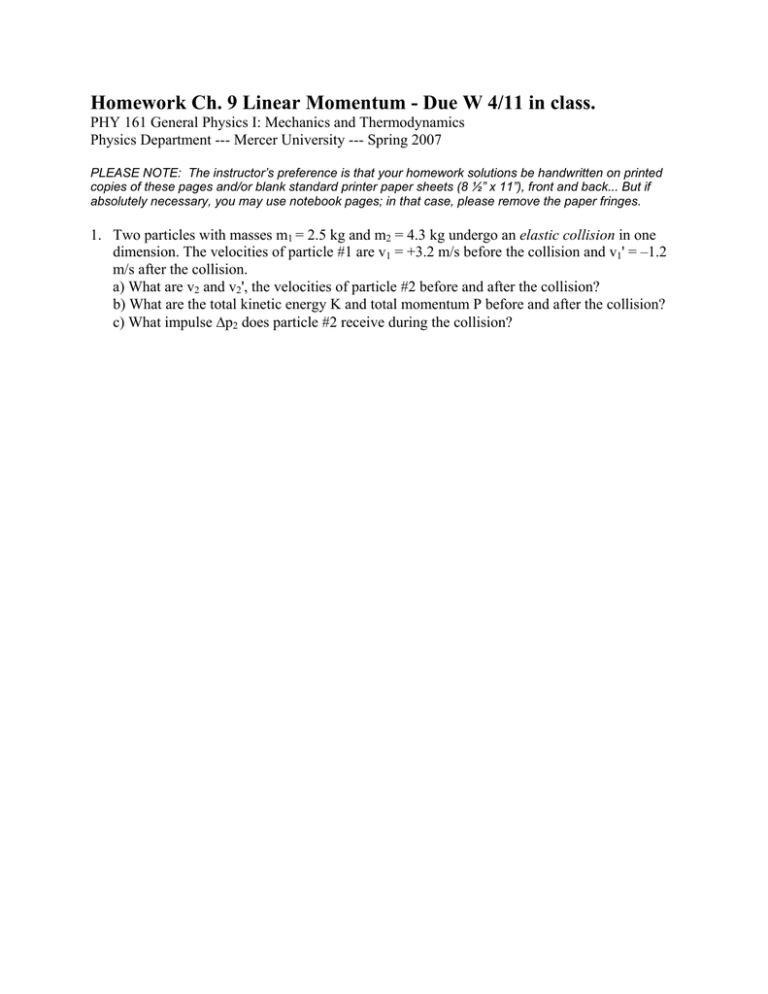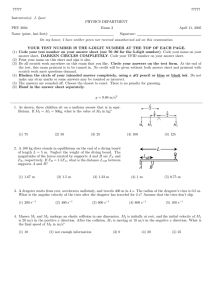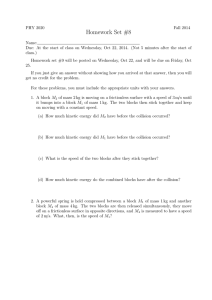Homework Ch. 9 Linear Momentum - Due W 4/11 in...
advertisement

Homework Ch. 9 Linear Momentum - Due W 4/11 in class. PHY 161 General Physics I: Mechanics and Thermodynamics Physics Department --- Mercer University --- Spring 2007 PLEASE NOTE: The instructor’s preference is that your homework solutions be handwritten on printed copies of these pages and/or blank standard printer paper sheets (8 ½” x 11”), front and back... But if absolutely necessary, you may use notebook pages; in that case, please remove the paper fringes. 1. Two particles with masses m1 = 2.5 kg and m2 = 4.3 kg undergo an elastic collision in one dimension. The velocities of particle #1 are v1 = +3.2 m/s before the collision and v1' = –1.2 m/s after the collision. a) What are v2 and v2', the velocities of particle #2 before and after the collision? b) What are the total kinetic energy K and total momentum P before and after the collision? c) What impulse Δp2 does particle #2 receive during the collision? 2. A large block with mass M = 2 kg sits at rest. It is put into motion by hitting it with BBs shot from a gun one at a time. Each BB has a mass mB = 1g and speed vB = 100 m/s. Your goal is to get the block to move at a final speed V = 5 m/s. a) If each BB is absorbed by the block (completely inelastic collision), how many BBs does it take to achieve your goal? b) If each BB bounces off the block (elastic collision), how many BBs does it take to achieve your goal? For this case only, make use of the fact that the mass of one BB is negligible compared to the mass of the block (mB « M) to make an approximate calculation. 3. At the left end of a rough tabletop of length D = 80 cm sits a block of mass mB = 30g. The coefficient of kinetic friction between block and tabletop is μκ = 0.2. Immediately to the left and right of the table stand two pendulums with identical masses m = 60g. The left pendulum is lifted to a height h = 40 cm and released. It strikes the resting block in an elastic collision. The block slides to the right and strikes the right pendulum in a completely inelastic (sticking) collision. They rise to a maximum height h'. What is h'? ALTERED SETUP: Suppose that the tabletop is polished to decrease μκ. If we repeat the entire procedure from the beginning, the block-pendulum combination rises to a new maximum height of 7.2 cm. What is the new value of μκ? 4. On a level frictionless tabletop are two blocks (masses: m1 = 1.1 kg, m2 = 1.2 kg) and a spring (spring constant: k= 500 N/m, platform mass: mP = 3 kg) as shown. At first block #1 moves to the right with speed v1 = 1.5 m/s, block #2 is at rest, and the spring is at rest and uncompressed. a) The blocks undergo an elastic collision. What are their velocities v1' and v2' after the collision? b) Block #2 then undergoes a completely inelastic (sticking) collision with the spring platform. What is their speed V after this collision? c) What is the maximum compression Δx of the spring? d) When the spring re-expands, block #2 separates from the spring platform, moving left with the same speed V as calculated in part b). It eventually undergoes another elastic collision with block #1. What are their velocities v1'' and v2'' after this collision? e) Total Energy: Calculate the energy Estart before any collisions, the energy Emiddle while the spring is compressed, and the final energy Eend after the collisions are over.








